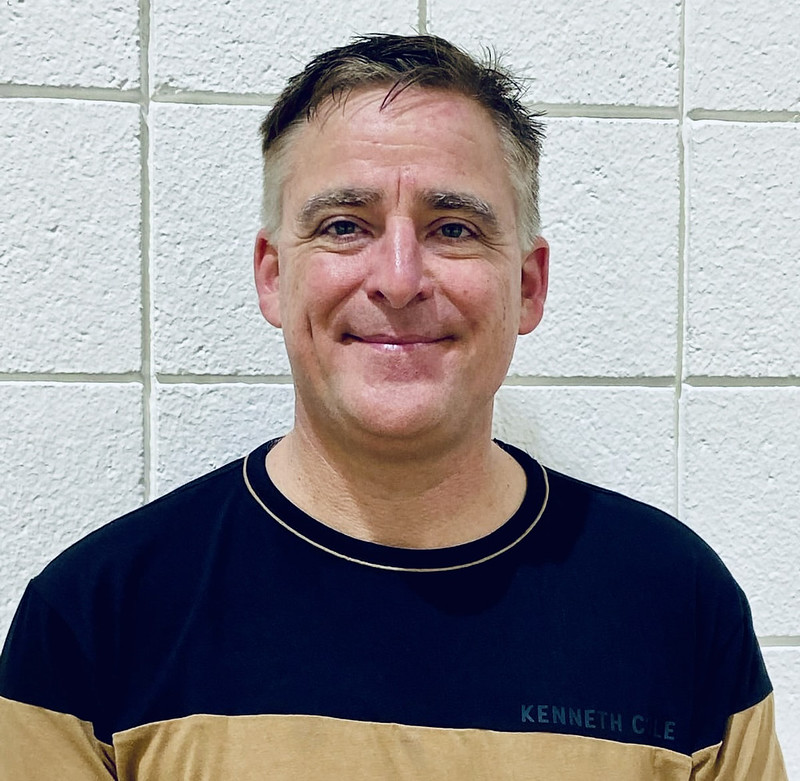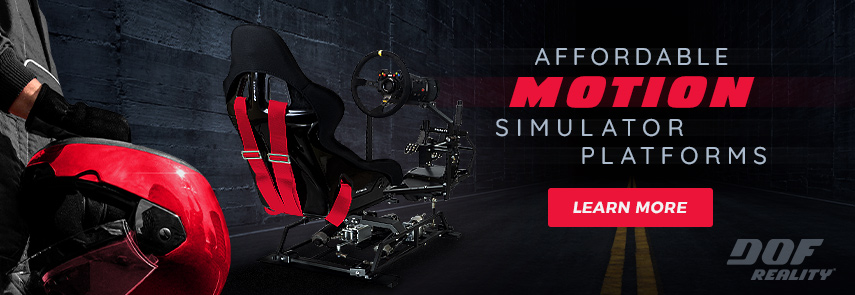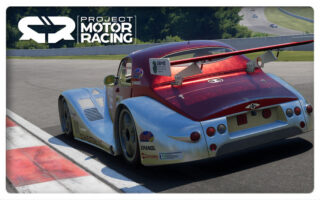Back in November of 2022, Ian Bell, co-founder of the famed SimBin modding team and later on, SimBin Studios and Slightly Mad Studios, announced that he founded a new studio branding named Straight4Games or just plain Straight4.
Back then Ian mentioned the support of well-known names from the industry such as Stephen Viljoen, Andy Garton, Stephen Baysted, Henrik Roos, AJ Weber, Johan Roos, Vik Klomiets, and ex-Top Gear Stig, Ben Collins to name a few.
Today, the new Studio launched its official Web site www.straight4.com, and with it published an interesting interview with Henrik Roos, and AJ Weber. It seems that Ian Bell means business when I quote ” Get back to basics: simulation (hardcore), and community (first and foremost).”
The studio plans to publish a monthly Straight4 newsletter, sharing exclusive updates, behind-the-scenes dev’ diaries, and work-in-progress screenshots.
Straight4 Quote:
Hendrik Roos – LEGENDARY GT-RACER AND STRAIGHT4 HANDLING CONSULTANT ON THE (SCARY) PAST AND (EXCITING) FUTURE
Henrik Roos rose to prominence in the late-’90s and early ’00s driving his epic Chrysler Viper GTS-R in the FIA GT Series. That’s around the time he joined up with Ian Bell with whom he developed one of the most beloved sims of all time—GTR. Someone who’s been on both sides of racing (sim and real) at the top level is sure to bring some unique insights.
You’ve been a pro racer in GT FIA and other world-class series. Do you have one standout memory?
HR: 24 Hours of Spa, 2003. Our Viper had a big crash at the Bus chicane, and everybody in the team almost gave up when I brought it back to the pits. But I told them, “We will fix it”, and with spares from our lookalike Viper (and a lot of duct tape!), we were again on the track after 1.5-hours and somehow finished the race. The car looked like a beaten-up boxer, but that’s racing and life. Never give up and keep fighting!
What was the scariest car you ever raced?
HR: BBR series at Anderstorp. I think it was 1998. I was entering the Lamborghini Challenge in a Diablo together with Carl Rosenblad. The car had a lot of power, but no brakes and no handling!
You became synonymous with the Chrysler Viper GTS-R from the early ’00s. That massive 8L V10 must have been something special to drive.
HR: That beast was brutal, just changing gears was heavy. I remember my last race in Dubai, the heat inside the cockpit was close to 80 degrees Celsius, and my racing shoes were melting. Quite a way to quit pro’ racing, leaving your melted shoes on the pedals!
What’s your role in Straight4?
HR: My experience is how a racing car feels and how to translate that to simulation. The feeling of a simulation is the most important thing. It’s now almost 20 years since GTR, so a lot of the cars from that era have become part of racing lore. The graphics will of course be amazing with the Unreal 5 Engine, and I really would love to get back behind the wheel of my old Viper—but this time without burning my feet! Can you imagine what that would be like with this new generation of physics engine and graphics.
You were closely involved in the original GTR games: Looking back, what are some of your favourite memories of that time and that era of motorsport and game-making?
HR: I think it was when we did the first GTR game in 2003, the passion from all the developers was fantastic. The development team was created from a mod group. Ian Bell, Johan Roos, and I decided to recruit this passionate and skilled group and make their hobby into a profession through SimBin Development Team AB. I took care of funding and administration, Ian Bell took care of the development team, and Johan Roos did the marketing. It was a fantastic time because we had few resources, but the result was fantastic, and I’m so happy GTR has gone on to become one of sim racing’s most loved sims. Being invited to bring that magic back is truly special for me, and I’m excited to get to work.
AJ Weber – PHYSICS DIRECTOR AT STRAIGHT4 GETS TO DO SOMETHING COOL: BUILD A NEW ENGINE FROM SCRATCH
AJ’s come a long way from the day he contacted the studio a decade ago and asked if he could try out his pet project’s tyre model. Turned out that project was spectacular. AJ’s gone on to work on many bestselling AAA-sim racers over the years, as well as a stint at Roborace. But the opportunity of building, from the ground up, a new physics engine, only comes along a couple of times in a career.
Looking back at 20 years in sim racing, what memory stands out for you?
AJ: My most satisfying moments are usually when an idea or invention just clicks, particularly when real life meets simulation. A standout memory? Working with a real-life GTLM driver on the simulation version of his race car during a test session. The driver brought up an issue about lacking “bite”. Bite, of course, is a common enough term, but it’s also one of those words that come with no single definition. Some drivers might say “front bite” and just mean front lateral grip, while other drivers mean something less obvious.
This driver, though, was not only expressing a transient behavior, but he also had the ability to express it in almost engineering terms. So, I proceeded to try to bolt on some things in the tyre model code itself, right there during the test session, to see if it would bring us closer to reality.
This was all just diagnostic at first, as we explored some cause and effect. Eventually, we came onto something that worked really well. That done, we pulled up the tyre rig analysis and immediately noticed something peculiar—something that looked physically natural as a vibrational behavior, but that wasn’t happening in the base tyre model as we were running it. Since we were running it at the sim’s 600 Hz tick rate, I raised the rate to 6,000 Hz (just adding a 0) and compared it to the modified tyre model at 600 Hz. The results were stunningly close. Now that was cool! A real-life driver had found something that the tyre model could already do but was not doing at our tick rate. He even calibrated, by feel, the new effect to an almost identical level to what just fell out of the base tyre model when we turned it up. Drivers do have a supernatural feel: working with them is critical in developing authentic handling.
Another similar case also happened with McLaren during development on-site with their primary driver on the 720S. The driver was describing what was off in terms of feel and handling as we were watching him drive. Then an on-hand Pirelli tyre engineer showed me a printout of something we had in front of our faces on a for-development-only HUD widget. Within an hour, after a few tweaks, the test driver was saying, “Now this is my car”.
How close are the current generation of sim engines to “reality”?
AJ: Lately I’ve been thinking of “realism” as having four types. I know they overlap, and any given aspect may not perfectly fit in this way of looking at it, but overall, I’ve been finding it useful to think of “Quantitative Realism”, “Qualitative Realism”, “Free of Unrealistic Exploits”, and “Realistic AI”.
The obvious one is “quantitative realism”. This is the easiest one to hit if you have enough data, or more commonly, the one that can demonstrate how a sim has messed up. Things like laptime matching, G matching, apex speed matching, tyre data matching, etc. It’s also the visible stuff that shows on videos, like how a car bounces on kerbs, how the suspension/body movement looks, etc. In other words, it’s how closely a sim matches measurable things from real life. For “quantitative realism”, I think the current generation of sim engines can get very close to available data and observations. However, we can’t quantitatively match what we can’t measure, and in the big picture, data is sparse.
My one-liner way of describing “qualitative realism” is that humans make realistic decisions in the cockpit. This ranges from micro-control up to tactical choices. And this requires that the brain must be immersed into realistic perception, feel, and cause/effect. By definition, this means working with real-life test drivers becomes key to achieving realism.
However, if the simulation delivers within the techniques a test driver knows are effective in real life, our job is still not complete. Part of what makes a pro a pro is how well they exploit what they do in real life, and not trying to do, in sims, what they can’t do in the real world. Sure, sim racing involves exploiting anything the sim gives you in the very same way as real-life pros exploit any advantage real life gives them—it’s called motor racing for a reason. But to be realistic, we can’t have unrealistic exploits, and that’s why we work with sim “aliens” in addition to real-life experts.
And finally, AI realism is a little “philosophical” and would require an entire paper on its own! Let’s just say, if there’s one thing that’s harder than making realistic vehicles for humans, it’s making a simulated human realistic for a vehicle.
What can we expect in terms of tyre models for your new physics engine?
AJ: A select few of the tyres in Project CARS 2 were the first next step in advancement, but they took much longer to calibrate and parameterize than the baseline tyres. When you get this right, there’s a more dynamic and organic feel, but if you get it even a little wrong, the physical simulation tells you so. While a lot of the math and solver stuff in the previous version of the model was correct, it could be computationally intensive and cumbersome to parameterize, even without the more advanced features. So, some of the new model is about better factoring of parameters as well as some significant optimizations.
After that, yes, a next version of both carcass and tread models are in the works, although in some ways these are simpler, taking advantage of much higher discretization than we could do before. The more resolution we can solve, the closer to first principles we can model, and then let more of the dynamics just fall out. For example, one goal is to have the “bite” feature mentioned above become obsolete because it can just fall out of the base model in real-time.
Is building a new physics engine from scratch a challenge or a blessing or a little of both and how?
AJ: Challenges are blessings, right?! So, a new physics engine is not just a little of both—it’s completely a challenge and a blessing. Software and math tools are constantly improving. Being able choose from a newer and better toolbox is certainly a blessing. But that comes with the challenge of having to implement all the unique systems necessary to simulate cars from scratch, even when for some systems, the old way was the right way after all.
TEST MULE GOES ON TRACK
AJ’s bespoke physics engine has been built from the ground up with no legacy architecture at all. This is a big step for the studio and, of course, the sim racing community. But for future sim racing historians (yes, they exist!), here’s a little factoid: the test mule the studio is currently using to validate theory inspired the name of the studio. That’s the straight-4 engine that came in a classic racer from the ’70s. Reason, why it’s such an effective test mule, is in its core design: lightweight, high-revving, rear-wheel drive, and prone to the most divine power slides.
In its second evolution and under the laser-gaze of a group of German specialists named Zakspeed (who built around five examples for Group 5 in late-’76), the 1800cc straight-4 engine was souped-up to some stratospheric degree and ended up producing around 250 incredibly loud horses at an ear-shattering 9,200RPM.
This car isn’t happy unless it’s in a sideways drift somewhere, so it’s an endlessly forgiving and fun ride.
Official Webpage – straight4.com
 Bsimracing Sim Racing Resources and News for the racing enthousiast.
Bsimracing Sim Racing Resources and News for the racing enthousiast.










